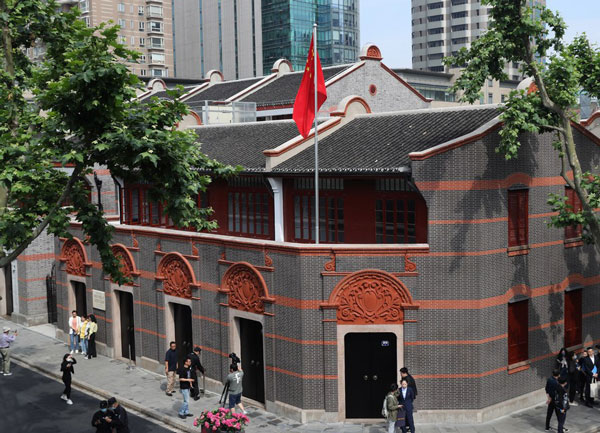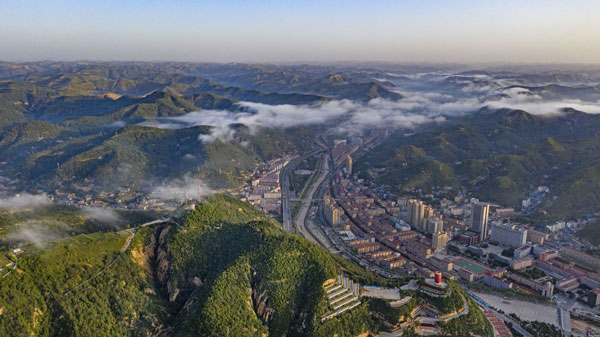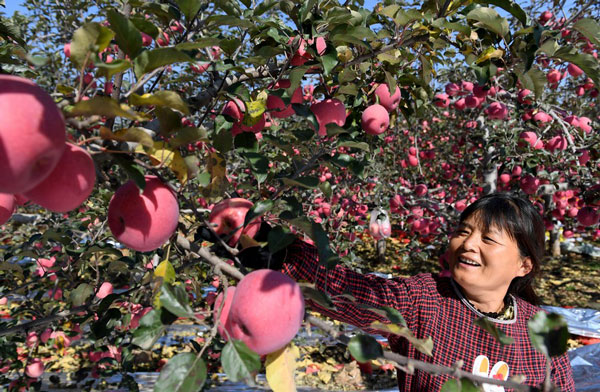
BEIJING — The two-story brick-and-wood house at 76 Xingye Road in Shanghai looks no different from other buildings in the vicinity. However, a secret meeting held inside the building 100 years ago changed the fate of the world's most populous country.
On July 23, 1921, the first national congress of the Communist Party of China (CPC) was convened in the house. The meeting marked the founding of the CPC — an epochal event in China's history.
Starting from there, the Party's leadership had moved across China strategically before settling in Beijing in 1949. Today the CPC has grown into the largest political party in the world with over 91 million members, and the country under its leadership has become the world's second-largest economy.
Vanguard in opening-up
Located at the estuary of the Yangtze River, Shanghai has been China's commercial center and a base of the country's working class since modern times, featuring openness, diversity and innovation.
After the founding of the People's Republic of China (PRC) in 1949, the city remained the country's economic powerhouse and has become a window of China's proactive integration into the international community.
Since the start of reform and opening-up in late 1970s, many foreign investors have chosen Shanghai as a testing ground in the Chinese mainland. They have been the participants and beneficiaries of the groundbreaking policy and experienced an ever-opening China in the CPC's birthplace.
Asia Pulp & Paper (APP), a subsidiary of Indonesian conglomerate Sinar Mas Group, entered China in 1992. Headquartered in Shanghai, the company has benefited from China's favorable trade policies and a continuously improving business environment in recent years, said Zhai Jingli, vice-president of APP China.
"The implementation of the Foreign Investment Law, including the further shortening of the negative list on foreign investment, has indeed brought more benefits to foreign investors and provided more long-term development opportunities," she added.

During the past ten years, Shanghai further stepped up its opening-up efforts. It established China's first pilot free trade zone in 2013 and has hosted the China International Import Expo for three years, the first dedicated import exhibition in the world.
In 2020, FDI in Shanghai hit a record high, topping $20.2 billion, up 6.2 percent year-on-year.
Farewell to poverty
After spending its early years in a metropolis, the CPC headquarters moved to rural, mountainous regions across China. During the rough journey, revolutionaries endured untold hardships and swept from victory to victory.
In November 1931, the CPC declared the establishment of the Provisional Central Government of the Soviet Republic of China in Ruijin, East China's Jiangxi province.
After the epic military maneuver of the Red Army — the Long March, Yan'an in Northwest China's Shaanxi province, and Xibaipo in North China's Hebei province, served as headquarters of the CPC successively.
Rooted in a glorious past, however, Ruijin, Yan'an and Xibaipo had all been stricken by chronic poverty due to harsh natural conditions and inaccessible locations.
Under the leadership of the CPC, people in these areas have all shaken off absolute poverty during the country's poverty alleviation campaign.

Yan'an, located on China's Loess Plateau, was marred by long-standing drought and soil erosion. American journalist Edgar Snow wrote in his 1937 book "Red Star over China" that the northern part of Shaanxi province, where Yan'an is located, was one of the poorest parts of China he had seen.
In 1941, CPC troops initiated a large-scale production campaign in Nanniwan Township about 40 km south of Yan'an. The move created a land of abundance and realized self-sufficiency amid military and economic sieges by the Kuomintang forces.
The miraculous achievement came through hard work and self-reliance, which constitute an important part of the Yan'an Spirit. Inheriting the spirit, impoverished locals had engaged in apple plantation, e-commerce and other businesses to combat poverty and won the battle in 2019, when Yan'an was removed from the poverty list.
By 2020, the city had over 266,800 hectares of apple orchards, the largest among China's prefecture-level cities, and its total output of apples accounted for one-twentieth of the global output, according to local authorities.
"About half of the per capita disposable income of farmers in Yan'an comes from growing apples," said Lu Shuguo, head of the Yan'an fruit industry center, adding that Yan'an apples have been exported to more than 30 countries and regions including Russia, Canada, Italy and the United Arab Emirates.
"Whether in the revolutionary years or in the era of modern development, the Yan'an spirit encourages generations of Chinese people to forge ahead and step into a new realm of development," said Tan Huwa, dean of the School of Marxism at Yan'an University.

Capital of future industries
In March 1949, the CPC Central Committee made the Fragrant Hills in suburban Beijing its headquarters and stayed there for half a year, where the Party led the Chinese People's War of Liberation to a countrywide victory.
The city that had been the capital during the reign of several dynasties in Chinese history was once again granted the title of capital when the PRC was founded in October that same year.
In addition to performing its functions as the country's political center, the historical city has also developed into a mega-metropolis with more than 20 million residents.
In August 2008, Beijing hosted the Summer Olympics and Paralympics. With the 2022 Beijing Winter Olympics scheduled for February, the city is slated to become the first to host both Summer and Winter Olympics.
The capital is rich in academic and innovative resources, with more than 90 universities, over 1,000 research institutions, and nearly 30,000 national-level high-tech enterprises. Zhongguancun in Beijing's Haidian district is deemed "China's Silicon Valley" where high-tech industries are located.

According to plans, the city's creativity, competitiveness and influence in innovation are expected to reach the top level globally as of 2035.
Beijing will be further integrated into the global innovation network through setting up global scientific research funds and strengthening joint research on global issues including climate change, energy, public health and artificial intelligence governance, according to Li Meng, vice-minister of science and technology.
As the blueprint rolls out, the capital of the world's largest socialist country, riding the waves of innovation, is set to lead China into a more remarkable future.